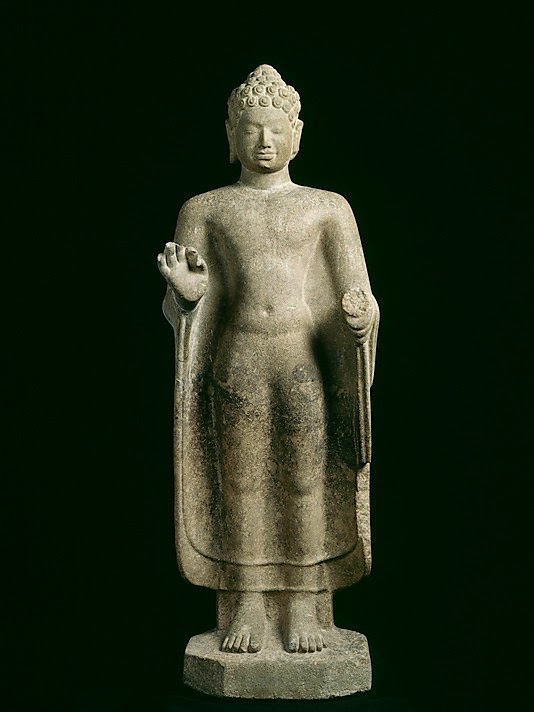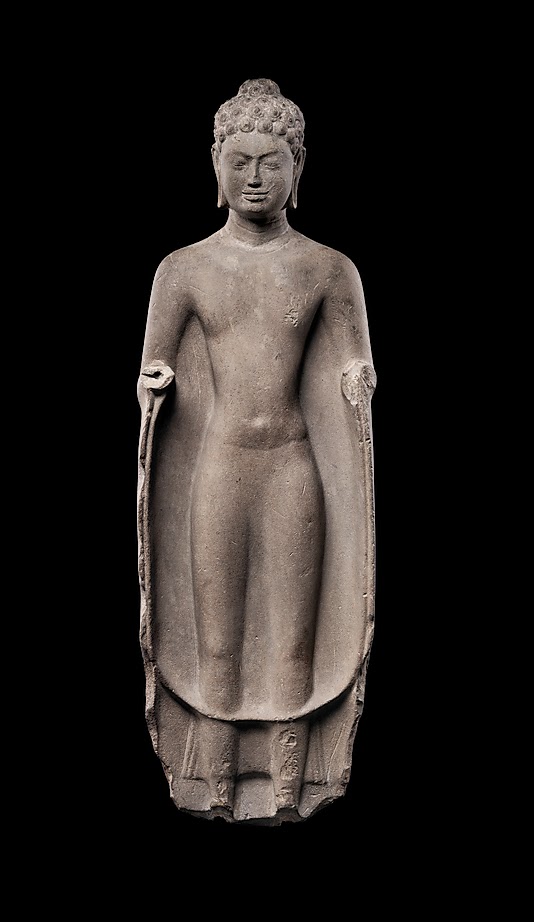For years, possibly decades, I have fumed and ranted about
the labels in many of the exhibitions at the Metropolitan Museum of Art. When I
visit exhibitions of art from outside Europe especially, I find myself confused
and frustrated, confronted with labels full of unfamiliar names of things and
places I can’t locate. With Italian Renaissance exhibitions (my Ph.D. is in
Italian Renaissance art) I understand the labels but am at a loss to figure out
why the label writer chose to use irrelevant, obscure, or evaluative statements,
for example describing an obviously mediocre painting as one of the most
beautiful of the artist’s career.
Last year’s Asian textile exhibition was an example. While I
was copying one of the labels from that exhibition, another visitor lingered by
the work. I explained that I wasn't copying the label because it was important,
but because it was awful and she replied that she had just read another label
that was useless to a general audience. She suggested that no one reads the
labels and that’s how the Met gets away with it. It’s a shame, because the Met has
access to the most important objects through its ability to get loans and the
highest level scholarship in its curators.
A year or two ago when the Islamic galleries opened I
couldn't understand what the labels were telling about the art; they were about
historical periods and movements and geography and rarely connected the object
I was looking at with anything that helped me to understand its purpose or
design. I have multiple examples in my notebooks that could be used in teaching
as examples of the worst labels imaginable.
I rant about this because some of us actually look at labels
to get a hook into seeing the work of art more clearly. I often wonder what
some figure is doing or what the story of the image is. Or I want to know why
the artist used a color, a material, a style, whatever. In the best of
circumstances, labels help create the narrative, the story of an exhibition. And
some exhibitions at the Metropolitan have succeeded in this, especially those
in the 19th-century department. But in other Met departments they
seem to be opportunities for graduate students to show off their erudition and
knowledge of arcane terminology. Why does the most visited art museum in the
country have some of the least helpful educational materials?
O.k., so in April, after reading Holland Cotter’s rhapsodic review in the Times, I made a point
of seeing Lost Kingdoms, the exhibition of pre-Angkor Southeast Asian art atthe Metropolitan. In this instance I had the advantage of having been to
Southeast Asia several years ago and having a soft spot for art from Cambodia.
For the first time in decades, I was able to follow the basic organization of the
exhibition, to understand that one room was dedicated to Buddhas and the advent
of Buddhism to Southeast Asia, one contained images of Vishnu, one of Shiva and
his associates, one of Bodhisattvas and even, through the introductory labels,
to have a sense of the role of these religious figures in the power structure
of the different cultures. At the same time, I have no real concept of the
cultures that created the sculptures or their pre-modern entities, and the
labels identified the works primarily by their modern source countries, the
geographical sites where they were excavated, rather than associate them with
the pre-modern political entities responsible for their creation.
Many of the objects in this exhibition are remarkable. A
wonderful thing the Met has done is to put images of ALL the objects in the
exhibition on its website, with their labels, as well as offering the works in
their exhibition groupings with the appropriate introductory labels. This does
not make it unnecessary to visit the exhibition, however, mainly because the
images give little idea of the scale of the works and don’t in any way reveal
their placement in each gallery, which really helps make connections between
them. Even showing photographs of
several views of some sculpture cannot substitute for the experience of walking
around them. And while photographs may give a hint of the beauty of the objects, in person they are astounding.
I can give a few examples of the objects I found most
memorable. The first one that caught my eye was a strangely posed figure with
exaggerated features, arms akimbo, crossed ankles, curly ringlets and leaves
around its head. It is identified as a yaksha, a figure from the “animistic
spirit cults” common in this region before the arrival of Buddhism. The space
held several other yakshas and I was able to grasp and remember the concept of
a nature-based animistic religion with these caricatured embodiments of spirits
that predated and perhaps set the stage for Buddhism in Southeast Asia.
In the next section, addressing the arrival of Buddhism in
Southeast Asia there are, understandable, a number of Buddhas. I got very
interested in three standing figures, all made of stone and approximately the
same size, about 39 inches high. At first glance they are similar, but closer
inspection reveals differences. The first, from the Musee Guimet in Paris, is considered
quite important for the inscription on its back. I must admit that the label
did not enlighten me about the reason the inscription is so important: “The sculpture’s importance is enhanced by
a contemporary Prakrit inscription on the reverse proclaiming the Ye dhamma
“stanza of causation” in a version of the text from northern India. It is among
the earliest known uses of the Ye dhamma stanza in early Cambodia,
foreshadowing its widespread appearance across Southeast Asia from the eighth
century onward. The style, like its counterparts in Dvaravati Thailand, looks
to the Saranth school of north India.“ I don’t know what Prakrit is,
have no idea what Ye dhamma “stanza of causation” means, and don’t remember
what Dvaravati Thailand has to do with it and never heard of the “Saranth
school of north India.” I did see the brief inscription on its back and duly
noted that it must be important. The figure itself is rather static and I think
of it as symmetrical, broad shoulders, small waist, a robe that falls in two
layers, and two feet solidly planted on the ground, with a peaceful expression
and a sensual, smooth surface.
One thing I noted in the exhibition was that most of the
object labels noted where and when the work was excavated or found, something I
really appreciate, partly because it lets me know how long the object has been
known to scholars, and partly because it gives a clue that the work was legally
excavated. I don’t see these notes in the online label copy.
So I noticed with interest that another Buddha image quitesimilar to this one, from the Met’s own collection, had no indication of where
or when it was excavated, only the accession number that tells me it was given
to the museum by Florence and Herbert Irving in 1993. Also quite symmetrical,
this one has neither feet nor hands and seems somehow more schematic than the
Musee Guimet version. Although this figure appears in the exhibition later than
the Guimet one, the label gives a clue as to what Sarnath is, a monastic school
in India with a prolific Buddha-making workshop.
A third standing Buddha, this one from the National Museumin Cambodia, caught my eye because its drapery was asymmetrical, something that
seemed very unusual. Also smoothly carved with a peaceful expression on its
youthful face, it had other characteristics that differentiated it from the
others. Like the other two, the man’s legs are visible through the drapery, but
I noticed a slight bulge in his belly above the belt. Then I saw that one leg
was just slightly in front of the other, one foot supporting just a little more
weight than the other, so he gives the sense of movement. Likewise, one
shoulder is slightly forward. The artist who carved this figure gave it an
exquisitely subtle sense of movement and life, while maintaining the Buddha’s
characteristically peaceful expression and overall mood. I kept coming back to
this sculpture, comparing it to the others, marveling at it. It is the object I
will remember from this exhibition.
Four seated Buddhas in the next gallery - from Myanmar,
Thailand, Vietnam and Cambodia - were fun to compare and impressively
monumental, even if the one from Vietnam is only 18 1/2 inches high. I needed
help to figure out which label was for which one, as the four labels were in a
square on one wall. And on the website they are not shown together so it is not
possible to imagine the mood they create, each on one side of a large
structure, in a low-lit room.
Then Vishnu, Durga and Garuda figures fill the next space,
with one strikingly movemented and dramatic figure of Krishna, its shadows
accentuated by the strong lighting.
Shiva and his associates, also connected
with the rulers, fill the following gallery. A couple of charming Ganeshas and
a very phallic linga attracted me here. But this is where I realized I was
getting tired. There’s not much to explain a relationship between Buddhism and
Hinduism anywhere in the exhibition, for example whether the two religions
intersected or characterized specific and separate cultures, rulers, or
kingdoms.
In the next gallery, State Art, I did stop and wonder at the
clay head of Buddha with eyes closed.
I think this was about the importance of
Buddhism for the state in ancient Thailand, as opposed to Hinduism, but at this
point I remembered that most people can’t distinguish the two completely
different religions from each other. Then a room of boddhisatvas, nicely
identified by their princely dress, changed the pace a little and revived me,
looking for the attributes of Maitreya and Avalokiteshvara.
In the end, I was not able
to get much sense of the cultures of this period in Southeast Asia, which
actually led me to find the subtlety and complexity of the sculptures all the
more wondrous. The exhibition is full of aesthetically amazing works of art and
one of the best things I saw in New York in April. But I sure wish the
Metropolitan Museum staff would work on those labels.





